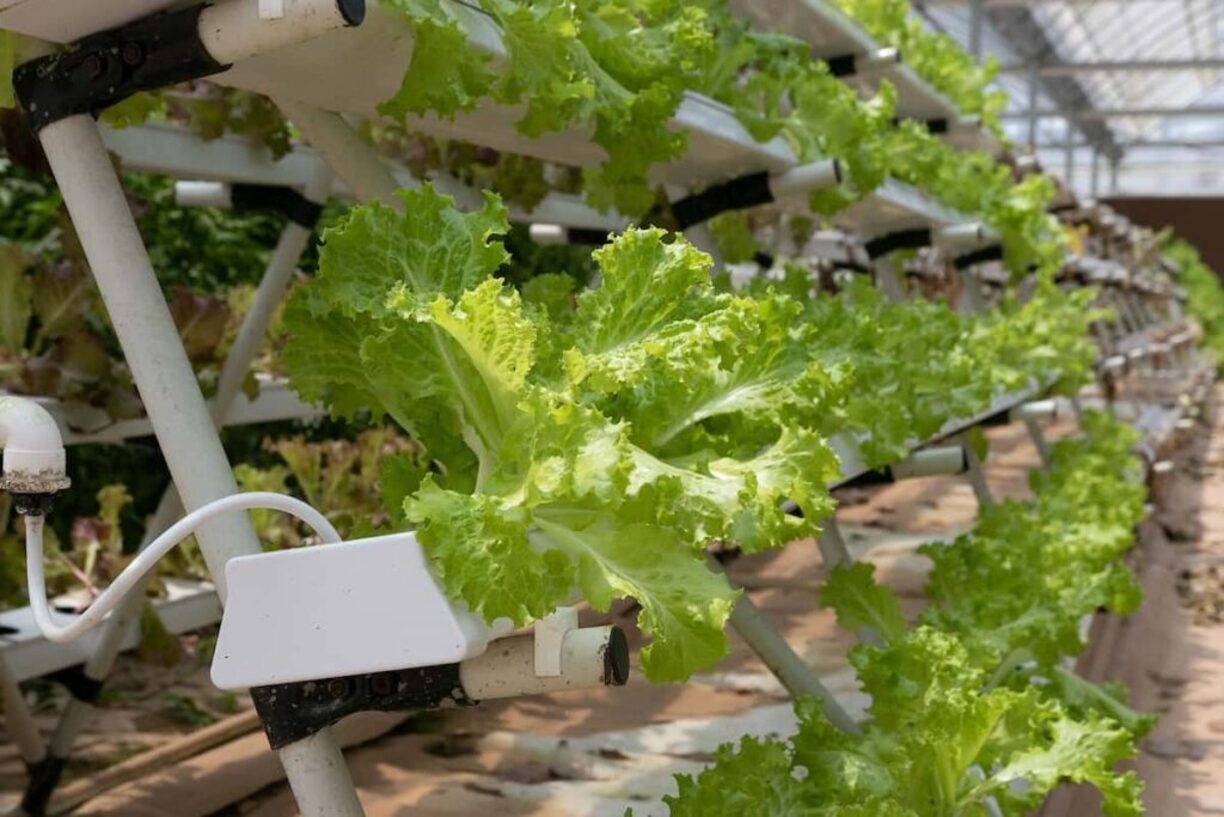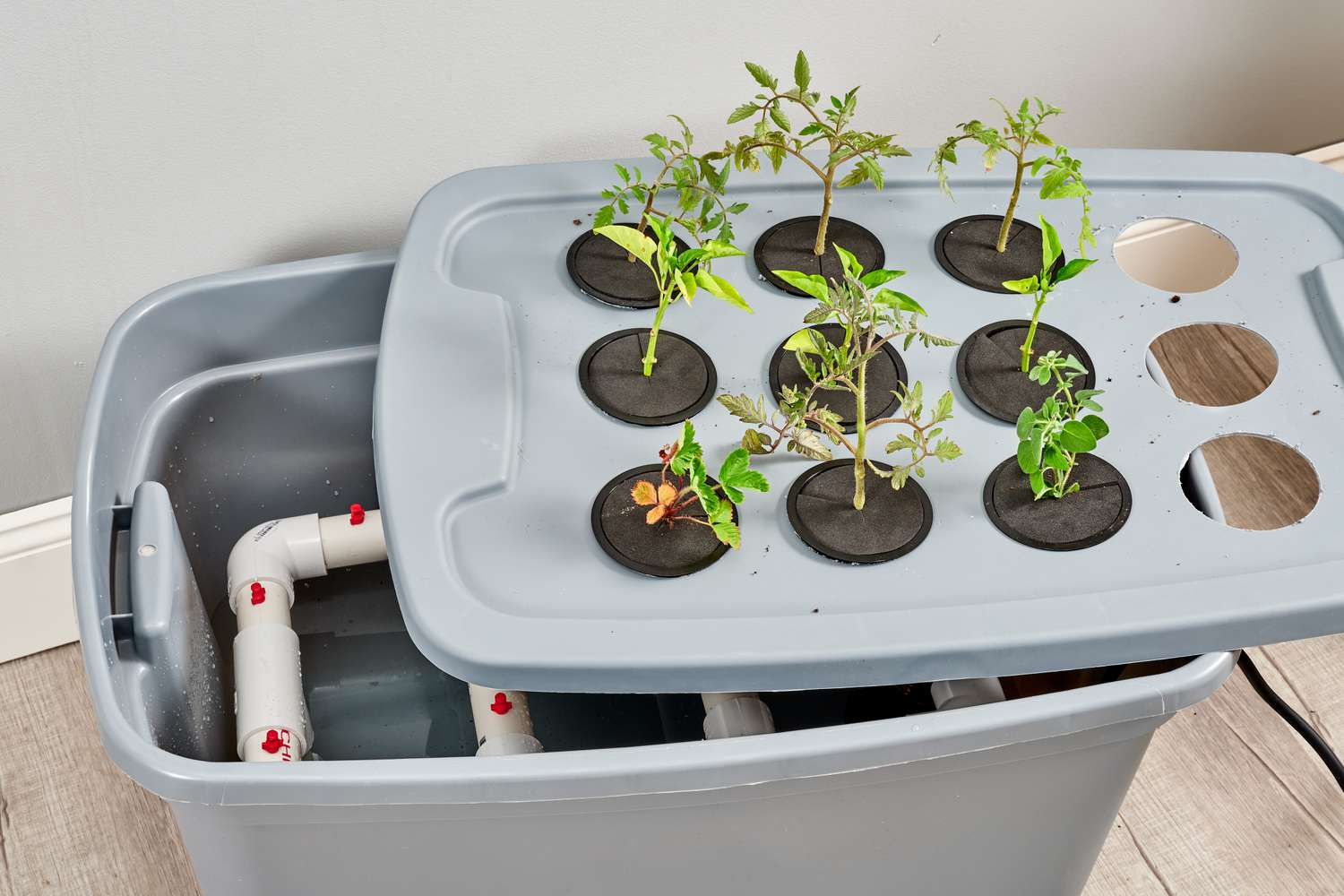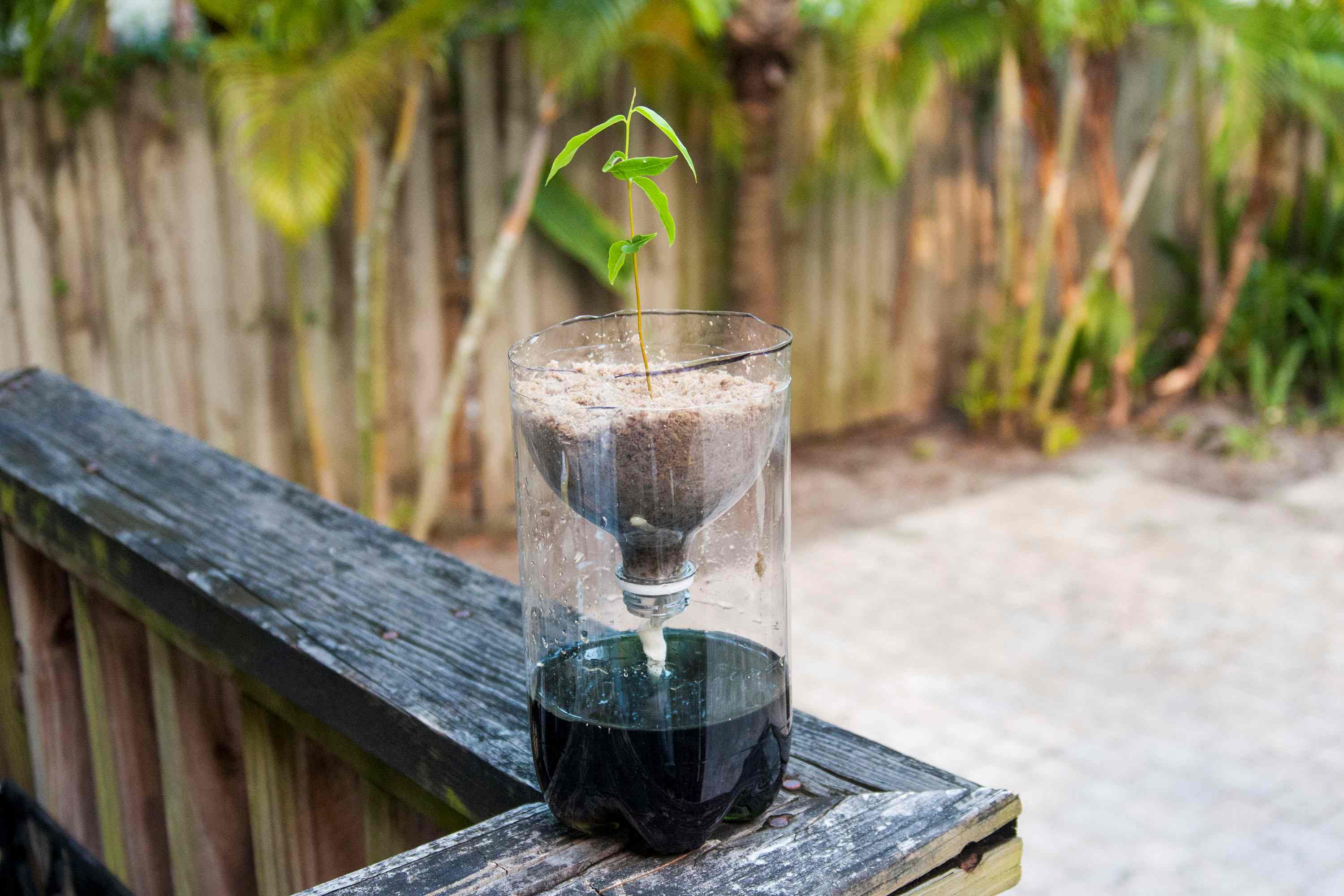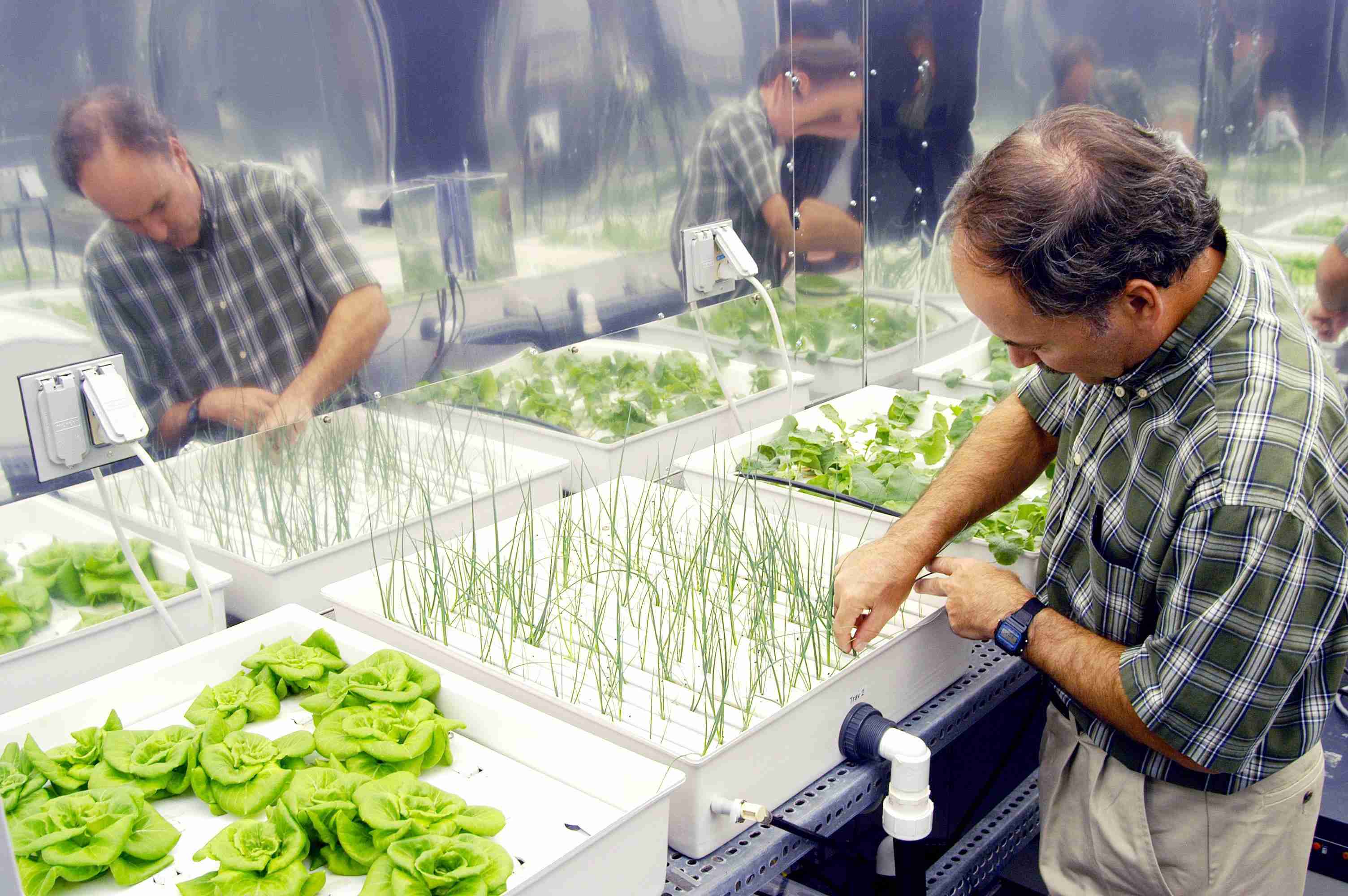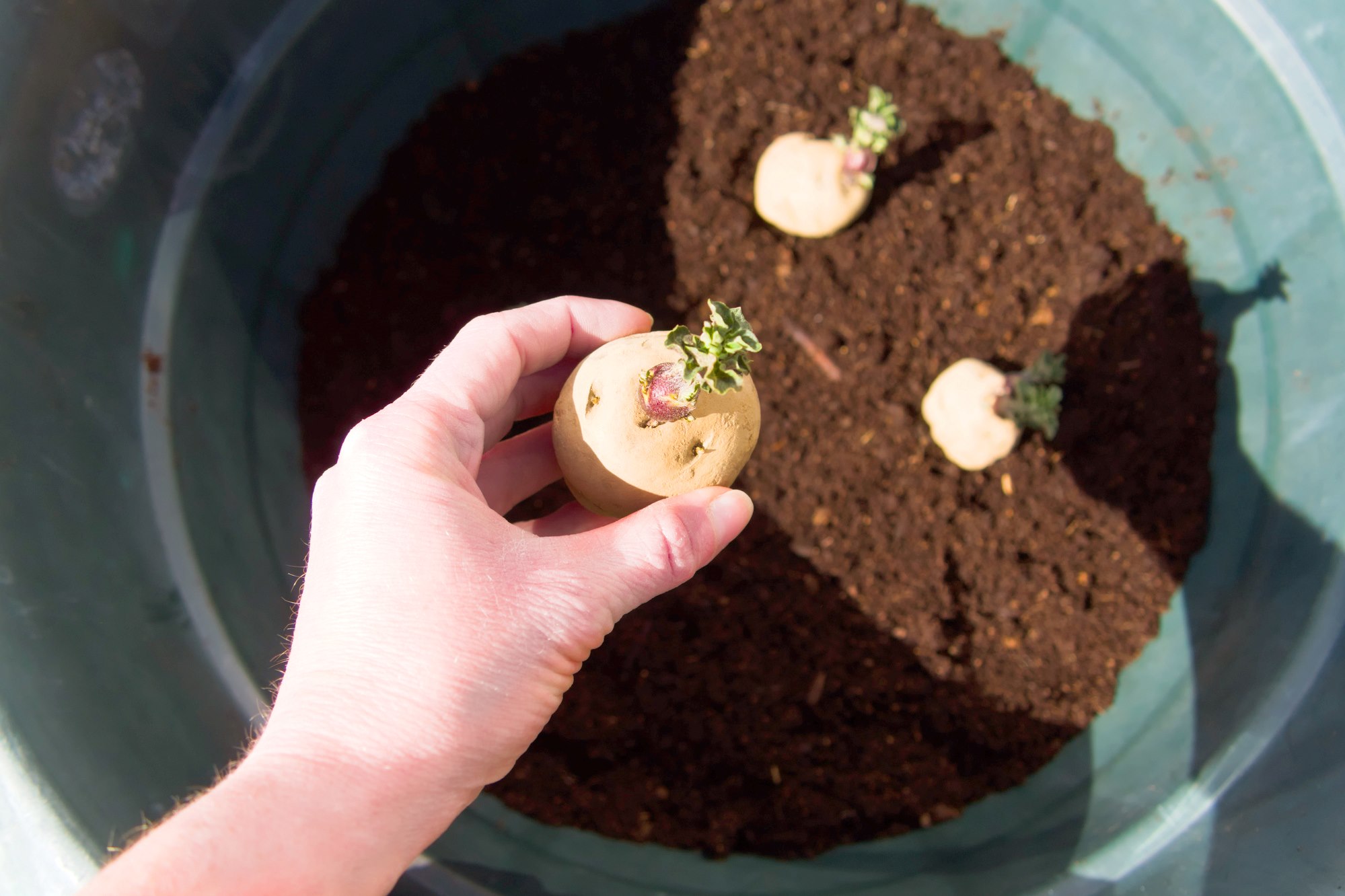Home>Gardening Tips and Tricks>Eco-Friendly Gardening>How To Set Up Ebb And Flow System For Hydroponics
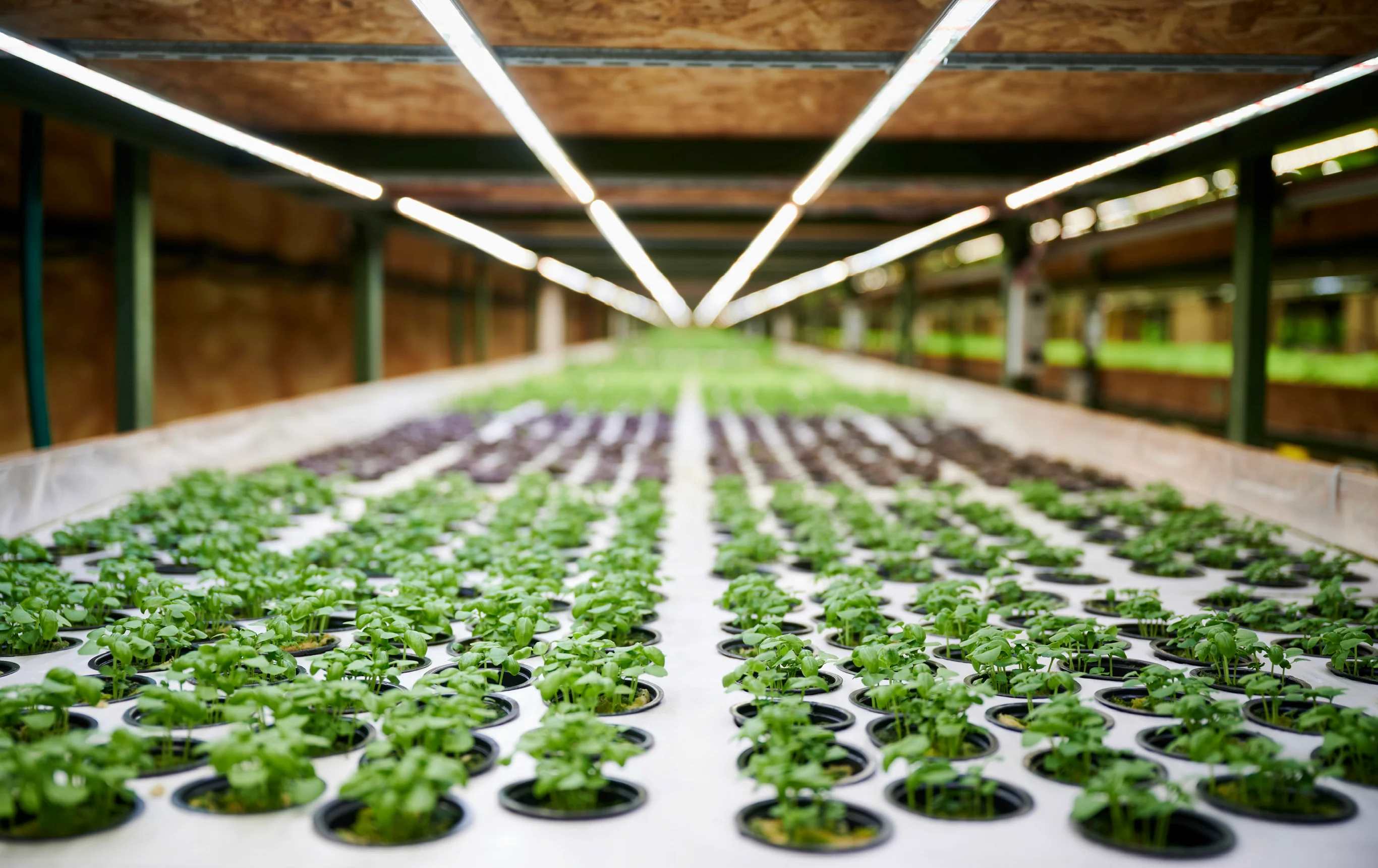

Eco-Friendly Gardening
How To Set Up Ebb And Flow System For Hydroponics
Modified: January 22, 2024
Learn how to practice eco-friendly gardening with our comprehensive guide on ebb and flow hydroponics, ensuring sustainable and efficient growing methods.
(Many of the links in this article redirect to a specific reviewed product. Your purchase of these products through affiliate links helps to generate commission for Chicagolandgardening.com, at no extra cost. Learn more)
Table of Contents
- Introduction
- What is Ebb and Flow Hydroponics?
- Benefits of Ebb and Flow Hydroponics
- Setting Up an Ebb and Flow System
- Choosing the Right Growing Medium
- Proper Nutrient Solution for Ebb and Flow Hydroponics
- Managing Water Levels and Timing
- Maintaining pH and EC Levels in Ebb and Flow Systems
- Troubleshooting Common Issues in Ebb and Flow Hydroponics
- Harvesting and Maintaining Plant Health
- Conclusion
Introduction
Welcome to the world of Ebb and Flow hydroponics! If you’re a gardening enthusiast looking for an eco-friendly and efficient way to grow your plants, then you’ve come to the right place. Ebb and Flow hydroponics, also known as flood and drain system, is a popular method that allows plants to grow without the need for soil.
This innovative gardening technique is gaining popularity due to its numerous benefits, including water conservation, optimal nutrient absorption, and space efficiency. Whether you have a small balcony or a spacious backyard, you can easily set up an Ebb and Flow hydroponic system to enjoy fresh, homegrown produce throughout the year.
So, what is Ebb and Flow hydroponics exactly? In simple terms, it is a system that alternates flooding the plant roots with nutrient-rich water and then draining it away. This cycle mimics the natural ebb and flow of tides, hence the name. The water and nutrients are delivered directly to the plants’ roots, ensuring maximum absorption and reducing the risk of over or under watering.
One of the key advantages of Ebb and Flow hydroponics is its flexibility. It can be used with a wide range of plants, including vegetables, herbs, flowers, and even fruit-bearing crops. Plus, it can be adapted to different scales, from small home setups to large commercial hydroponic farms.
In this comprehensive guide, we will delve deeper into the world of Ebb and Flow hydroponics. We will explore the benefits of this method, provide step-by-step instructions to set up your own system, and offer tips to maintain healthy plants. Whether you are a beginner or an experienced gardener, this article will equip you with the knowledge to embark on your Ebb and Flow hydroponic gardening journey.
What is Ebb and Flow Hydroponics?
Ebb and Flow hydroponics, also known as flood and drain system, is a popular method of growing plants without the use of soil. It is a versatile and efficient technique that allows gardeners to cultivate a wide variety of plants, from herbs and vegetables to flowers and fruits. In an Ebb and Flow system, plants are placed in a tray or container filled with a growing medium, such as perlite or coconut coir.
The system works on the principle of periodically flooding the plant roots with a nutrient-rich water solution and then draining it away. This mimics the natural rise and fall of tides, hence the name “Ebb and Flow”. The flooding cycle is controlled by a timer or a pump, ensuring that the plants receive the necessary nutrients while preventing waterlogging.
Ebb and Flow hydroponics offers several advantages over traditional soil-based gardening. Firstly, it promotes efficient water usage. Unlike traditional gardening methods that require a significant amount of water to reach the plant roots, Ebb and Flow systems allow for targeted and precise nutrient delivery. The excess water is drained away, reducing the risk of overwatering and water wastage. This makes Ebb and Flow hydroponics a sustainable choice for water-conscious gardeners.
Secondly, this technique optimizes nutrient absorption. The nutrient-rich water solution is carefully formulated to meet the specific nutritional requirements of the plants. By delivering the nutrients directly to the roots, the plants can absorb them more efficiently, resulting in faster growth and higher yields. Additionally, the controlled environment of Ebb and Flow systems minimizes the risk of nutrient leaching, ensuring that the plants receive the ideal balance of nutrients they need to thrive.
Furthermore, Ebb and Flow hydroponics offers a space-saving solution for gardening. Since the plants are grown without soil, there is no need for large garden beds or expansive outdoor spaces. This makes it an excellent option for urban dwellers or those with limited garden space. Ebb and Flow systems can be set up in small containers or vertical gardens, maximizing the use of space while still providing abundant harvests.
Overall, Ebb and Flow hydroponics is a versatile and sustainable gardening method that offers numerous advantages. Whether you’re a beginner or an experienced gardener, this technique provides an opportunity to grow your own plants in a controlled and efficient manner. In the next sections, we will explore the benefits of Ebb and Flow hydroponics in more detail and provide practical tips for setting up and maintaining your own system.
Benefits of Ebb and Flow Hydroponics
Ebb and Flow hydroponics offers a range of benefits that make it an attractive gardening method for both beginners and experienced growers. Let’s take a closer look at some of these advantages:
- Water Efficiency: One of the primary benefits of Ebb and Flow hydroponics is its water efficiency. The system allows for precise water delivery directly to the plant roots, eliminating water wastage. The excess water is drained away, preventing waterlogging and conserving water resources.
- Nutrient Optimization: In an Ebb and Flow system, the nutrient solution is carefully formulated to meet the specific needs of the plants. This targeted delivery of nutrients directly to the roots ensures optimal nutrient absorption, promoting healthy plant growth and high yields. Additionally, the controlled environment reduces the risk of nutrient leaching, ensuring that the plants receive the ideal balance of nutrients.
- Space Efficiency: Ebb and Flow hydroponics is an excellent choice for gardeners with limited space. Since plants are grown without soil, the system can be set up in small containers or vertical structures, maximizing the use of space. This makes it suitable for urban gardening, balcony gardens, and indoor setups.
- Year-round Growing: With Ebb and Flow hydroponics, you can grow your favorite plants all year round. The controlled environment allows for consistent growing conditions, unaffected by seasonal changes. This means you can enjoy a continuous harvest of fresh produce, regardless of the time of year.
- Pest and Weed Control: By eliminating the use of soil, Ebb and Flow hydroponics reduces the risk of pests, diseases, and weeds. Plants grown in this system are less susceptible to soil-borne pathogens and weed infestations. This minimizes the need for chemical pesticides and herbicides, making it an environmentally friendly choice.
- Optimal Oxygen Levels: Proper oxygenation is crucial for healthy root development, and Ebb and Flow hydroponics excels in providing optimal oxygen levels. During the drainage phase, the roots are exposed to oxygen, promoting better root growth and nutrient uptake.
- Flexibility and Versatility: Ebb and Flow hydroponics can accommodate a wide range of plants, including vegetables, herbs, flowers, and even fruit-bearing crops. The system can be scaled up or down, depending on your needs and available space. This versatility allows you to experiment with different plants and grow a diverse garden.
These are just a few of the many benefits that Ebb and Flow hydroponics has to offer. By adopting this innovative gardening technique, you can enjoy efficient water usage, maximize yields, and grow your own plants in a space-saving and sustainable manner. In the next sections, we will guide you through the process of setting up and maintaining your own Ebb and Flow hydroponic system.
Setting Up an Ebb and Flow System
Setting up an Ebb and Flow hydroponic system may seem daunting at first, but with the right guidance, it can be a straightforward process. Here, we will provide you with step-by-step instructions on how to set up your own Ebb and Flow system:
- Choose the Container: The first step is to select a container for your Ebb and Flow system. It can be a plastic tray, a grow bed, or even a repurposed container like a plastic storage bin. Ensure that the container is watertight and large enough to accommodate the plants you wish to grow.
- Install the Drainage Valve: Next, you’ll need to install a drainage valve at the bottom of the container. This will allow you to control the water levels in the system. Make sure the valve is secure and leak-proof.
- Add the Growing Medium: Fill the container with a suitable growing medium, such as perlite, coconut coir, or expanded clay pellets. The growing medium should provide stability for the plants and allow for adequate water drainage.
- Position the Plants: Carefully place your plants in the growing medium, ensuring that the roots are securely tucked in. Make sure to space them appropriately to allow for proper growth and airflow.
- Connect the Pump and Timer: Set up a water pump in a separate reservoir or bucket, and connect it to a timer. The timer will control the flooding and draining cycles of the system. This ensures that the plants receive nutrient-rich water at regular intervals.
- Attach the Water Delivery Tubing: Use flexible tubing to connect the water pump to the container. Position the tubing so that it evenly distributes the water across the growing medium. This will ensure that all plants receive equal amounts of water and nutrients.
- Test the System: Before fully operational, it is essential to test the system. Turn on the pump and check if the water floods the container evenly. Adjust the tubing and water levels as needed to achieve optimal distribution.
- Monitor and Adjust: Once your Ebb and Flow system is up and running, it’s crucial to monitor it regularly. Check the water levels, nutrient solution, and pH levels to ensure everything is in balance. Make adjustments as necessary to maintain optimal growing conditions for your plants.
Remember, each Ebb and Flow system may have unique requirements, and you may need to make adjustments based on the specific needs of your plants. Take the time to understand the optimal water and nutrient requirements for the crops you are cultivating.
By following these steps, you can successfully set up your own Ebb and Flow hydroponic system. Next, we will discuss the different growing mediums that are suitable for Ebb and Flow systems, helping you decide which one will work best for your gardening needs.
Choosing the Right Growing Medium
When setting up an Ebb and Flow hydroponic system, choosing the right growing medium is crucial for the success of your plants. The growing medium provides support, retains moisture, and allows for proper root development. Here are some popular growing mediums that are suitable for Ebb and Flow systems:
- Perlite: Perlite is a lightweight volcanic rock that provides excellent aeration and drainage. It is commonly used in hydroponic systems due to its ability to retain moisture while preventing waterlogging. Perlite also helps to distribute nutrients evenly throughout the root zone.
- Coconut Coir: Coconut coir, derived from the husks of coconuts, is a sustainable and renewable growing medium. It has excellent water retention properties while promoting proper drainage. Coconut coir has a neutral pH and is resistant to fungal diseases, making it a popular choice for Ebb and Flow systems.
- Expanded Clay Pellets: Also known as hydroton or clay pebbles, expanded clay pellets have excellent drainage capabilities. These lightweight balls of baked clay retain moisture well, allowing for sufficient oxygenation of the roots. Expanded clay pellets are reusable and provide stability for plants during flooding and draining cycles.
- Vermiculite: Vermiculite is a natural mineral substance that holds moisture and nutrients in its layered structure. It has good water retention properties and promotes aeration around the roots. Vermiculite helps to prevent overwatering and nutrient leaching, creating a favorable environment for plant growth in Ebb and Flow systems.
- Rockwool: Rockwool is made from volcanic rock or basalt and is commonly used in hydroponic systems. It has excellent water retention and aeration properties and provides a stable substrate for plant roots. Rockwool can be easily cut and shaped to fit the Ebb and Flow system’s container.
When choosing a growing medium, consider factors such as water retention, aeration, pH buffering capacity, and availability. It’s important to note that some growing mediums may require additional preparation, such as rinsing or soaking, before use to remove any excess dust or nutrients that could affect the plant’s health.
Experimenting with different growing mediums can help you determine which one works best for your specific plants and growing environment. Remember to regularly monitor the moisture levels of the growing medium and adjust watering cycles accordingly to ensure optimal growing conditions for your plants.
In the next section, we will discuss the proper nutrient solution for Ebb and Flow hydroponics, ensuring your plants receive the essential nutrients they need to thrive.
Proper Nutrient Solution for Ebb and Flow Hydroponics
Properly formulating and managing the nutrient solution is essential for the success of your Ebb and Flow hydroponic system. The nutrient solution provides the necessary elements for plant growth and development. Here are some key considerations for creating and maintaining the proper nutrient solution:
- Essential Nutrients: The nutrient solution should contain all the essential elements required for plant growth, including macronutrients (nitrogen, phosphorus, potassium) and micronutrients (iron, manganese, zinc, etc.). These nutrients are typically obtained from hydroponic-specific fertilizers that are formulated to meet the specific needs of plants grown without soil.
- Nutrient Solution Concentration: It is crucial to measure and maintain the appropriate concentration of nutrients in the solution. This can be done by monitoring the Electrical Conductivity (EC) level, which indicates the nutrient concentration. Different plants have different nutrient requirements, so it’s essential to refer to specific guidelines for each plant variety you are growing.
- pH Levels: The pH level of the nutrient solution affects nutrient availability to the plants. Most plants thrive in a pH range of 5.5 to 6.5. Regularly monitor and adjust the pH of the nutrient solution using pH testing kits or pH regulators to ensure optimal nutrient uptake.
- Nutrient Solution Temperature: The temperature of the nutrient solution should be maintained within an ideal range for optimal plant growth. Most plants prefer a nutrient solution temperature between 18°C and 24°C (65°F – 75°F). Using a water heater or chiller can help adjust the solution temperature as needed.
- Monitoring and Adjusting: Regularly monitor the nutrient solution’s EC levels, pH levels, and temperature. This can be done using appropriate testing equipment and meters. If necessary, make adjustments by adding additional nutrients or changing the concentration to ensure the plants receive the proper balance of nutrients.
- Flushing the System: Over time, nutrient buildup may occur in the system. To prevent the accumulation of excessive salts, it is important to periodically flush the system. This involves draining the old nutrient solution and replacing it with fresh, properly balanced solution.
- Following Manufacturer Instructions: Different nutrient brands may have specific instructions for their products. It is important to follow the manufacturer’s guidelines for the proper usage and dilution of their fertilizers to ensure optimal plant health.
Remember to keep a log of the nutrient solution’s composition, pH levels, and any adjustments made. This will help you monitor and refine your nutrient management practices over time.
By providing your plants with a properly balanced nutrient solution, you will support their growth, promote healthy foliage, and maximize yield potential. In the next section, we will discuss managing water levels and timing in your Ebb and Flow hydroponic system.
Managing Water Levels and Timing
Managing water levels and timing is crucial for the success of your Ebb and Flow hydroponic system. Proper management ensures that your plants receive the right amount of water and nutrients at the correct intervals. Here are some key points to consider when managing water levels and timing:
- Flooding and Draining: The Ebb and Flow system relies on a cyclical process of flooding and draining the nutrient-rich water. Typically, the flooding cycle lasts for a specific duration, allowing the plants’ roots to absorb water and nutrients. The draining phase removes the excess water, preventing waterlogging and ensuring sufficient oxygenation.
- Water Level: It is important to maintain the appropriate water level in the system. During the flooding phase, the water should reach a level that fully submerges the root zone, allowing for easy nutrient absorption. The drainage phase should remove excess water, leaving the roots aerated.
- Timing and Frequency: The timing and frequency of flooding and draining cycles depend on several factors, including plant type, growth stage, temperature, and evaporation rate. As a general guideline, it is recommended to flood the system for about 15-30 minutes at a time, 3-4 times a day. However, it is important to adapt these timings based on the specific needs of your plants and environmental conditions.
- Monitoring Water Levels: Regularly monitor the water levels in the system to ensure they are within the desired range. This can be done visually by checking the container’s water level or by using water level sensors for automated systems. Adjust the water levels as needed to maintain optimal conditions.
- Water Quality: The quality of the water used in your Ebb and Flow system is also important. Ensure that the water source is clean, free from contaminants, and has the appropriate pH and EC levels. If necessary, filter or treat the water to meet the specific requirements of your plants.
- Automation and Timers: Using timers or automated systems can greatly simplify the management of water levels and timing in your Ebb and Flow system. Timers control the flooding and draining cycles, ensuring consistency and precision in water delivery to the plants.
- Monitoring Plant Health: Regularly observe the health and growth of your plants. Wilting, yellowing leaves, or excessively damp conditions may indicate improper water levels or timing. Adjust the system accordingly to address any issues and ensure the overall health of your plants.
Remember, each plant variety may have specific water requirements, so it’s crucial to understand the needs of the plants you are growing and make adjustments accordingly. By effectively managing water levels and timing, you will provide your plants with the optimal growing conditions they need to thrive in your Ebb and Flow hydroponic system.
In the next section, we will discuss the importance of maintaining proper pH and EC levels in your Ebb and Flow hydroponic system.
Maintaining pH and EC Levels in Ebb and Flow Systems
Maintaining proper pH and EC (Electrical Conductivity) levels is crucial in Ebb and Flow hydroponic systems to ensure optimal nutrient uptake and prevent nutrient imbalances. pH refers to the acidity or alkalinity of the nutrient solution, while EC measures the concentration of dissolved salts in the solution. Here are some key points to consider when maintaining pH and EC levels:
- pH Level: The pH level of the nutrient solution greatly influences nutrient availability and absorption by plants. Most plants thrive in a slightly acidic to neutral pH range of 5.5 to 6.5. Regularly monitor the pH level using a pH testing kit or meter, and adjust it as necessary. pH adjusters, such as pH up or pH down solutions, can help you bring the pH to the desired range.
- EC Level: EC, or Electrical Conductivity, is a measure of the concentration of dissolved salts in the nutrient solution. It indicates the nutrient strength and can affect plant growth and health. Different plants have specific EC requirements, so it’s important to refer to recommended guidelines. Use an EC meter to regularly measure the EC level, and adjust it by diluting or adding nutrients to maintain the desired range.
- Monitoring and Adjusting: Regularly monitor the pH and EC levels of your nutrient solution, ideally on a daily basis. This will help you identify any imbalances or fluctuations that may affect plant health. Make adjustments as necessary to keep the levels within the optimal ranges for your plants.
- PH Buffers: Some growing mediums, such as coconut coir or rockwool, may naturally have a higher or lower pH level. To buffer the pH and prevent large fluctuations, pre-soak or rinse the growing medium before use. This will help stabilize the pH and create a favorable environment for root growth.
- Water Quality: The quality of the water used in your system can also affect pH and EC levels. Test the water source periodically to ensure it meets the desired parameters. If necessary, use water filters or treatments to remove impurities or adjust the pH and EC levels.
- Keep Records: Keeping detailed records of your pH and EC measurements, as well as any adjustments made, is crucial for maintaining consistency and identifying trends over time. This will help you make informed decisions and fine-tune your nutrient management practices.
- Regular Flushing: Periodically flushing the system with fresh, pH-balanced water can help prevent nutrient buildup and maintain optimal pH and EC levels. This flush removes excess salts and restores the proper nutrient balance in the solution.
- Consult Guidelines: Different plant varieties may have specific pH and EC requirements. Refer to specific guidelines or consult reputable sources for recommended ranges to ensure optimal plant growth.
Maintaining proper pH and EC levels in your Ebb and Flow hydroponic system is essential for providing your plants with the appropriate nutrient balance. Regular monitoring and adjustments will go a long way in supporting healthy growth and maximizing yields.
In the next section, we will discuss some common issues that may arise in Ebb and Flow hydroponics and provide troubleshooting tips to address them.
Troubleshooting Common Issues in Ebb and Flow Hydroponics
While Ebb and Flow hydroponics is a relatively straightforward method, challenges may arise from time to time. Here are some common issues and troubleshooting tips to help you address them:
- Plant Wilting: If your plants are wilting, it may indicate overwatering or underwatering. Check the water levels in the system and adjust accordingly. Wilting may also be a sign of nutrient deficiency or pH imbalance, so check the nutrient solution and pH levels as well.
- Yellowing Leaves: Yellowing leaves can be a symptom of various issues. It may indicate nutrient deficiencies, such as iron or magnesium. Ensure that the nutrient solution is properly balanced and provides all the necessary elements for plant growth. Also, check the pH levels, as nutrient uptake can be affected by pH imbalances.
- Root Rot: Root rot can occur when the roots are constantly exposed to excessive moisture. This can happen if the drainage system is inadequate or if the nutrient solution is continuously flooding the root zone. Ensure proper drainage and monitor water levels to prevent root rot. Consider adding beneficial bacteria or using hydrogen peroxide in moderation to help control root rot.
- Algae Growth: Algae growth in your Ebb and Flow system can be a common issue, especially if there is prolonged exposure to light. To prevent algae growth, ensure that your system is properly covered or shielded from direct sunlight. You can also implement black-out periods or use algae control solutions to inhibit their growth.
- Pump Issues: If your water pump is not working correctly, check for clogs or debris that may be obstructing the flow. Clean or replace any faulty parts as needed. It is also a good practice to have a backup pump available in case of emergencies.
- Nutrient Imbalances: Nutrient imbalances can negatively affect plant health and growth. Monitor the pH and EC levels regularly and adjust the nutrient solution as needed. Additionally, ensure that you are providing the correct nutrient solution concentrations for the specific plant varieties you are growing.
- Pests and Diseases: While Ebb and Flow hydroponics reduces the risk of soil-borne pests and diseases, it is still possible to encounter other types of pests such as fungi, aphids, or spider mites. Use organic pest control methods such as neem oil or introduce beneficial insects to manage pest problems. Regular monitoring and maintaining good hygiene in the system are essential in preventing and managing pest and disease issues.
Remember, troubleshooting is an ongoing process in hydroponic gardening. Effective problem-solving requires close observation, regular monitoring, and taking prompt action. By addressing issues proactively, you can maintain a healthy and thriving Ebb and Flow hydroponic system.
In the final section, we will discuss harvesting and maintaining plant health in your Ebb and Flow hydroponic system.
Harvesting and Maintaining Plant Health
Harvesting your plants is the exciting culmination of your hard work in your Ebb and Flow hydroponic system. Proper harvesting techniques and ongoing maintenance are essential to ensure the continued health and productivity of your plants. Here are some tips for harvesting and maintaining plant health:
- Harvesting: When it comes to harvesting, timing is crucial. Follow the recommended guidelines for each plant species regarding the ideal stage for harvesting. Use clean, sharp tools to minimize damage to the plants. Harvest leafy greens by harvesting outer leaves while allowing the inner leaves to continue growing. For fruit-bearing crops, harvest when the fruits are fully ripened and ready to be picked.
- Pruning and Trimming: Regularly prune and trim your plants to promote healthy growth and shape. Remove any dead or damaged foliage and trim excessive growth to maintain an optimal size and shape. Pruning and trimming also help improve airflow and reduce the risk of fungal diseases.
- Pest and Disease Monitoring: Keep a close eye on your plants for any signs of pests or diseases. Regularly inspect the leaves and stems for discoloration, spots, or signs of insect infestation. If any issues are detected, take appropriate action promptly. Implement organic pest control methods or consult a professional if necessary to prevent further damage to your plants.
- Maintaining Nutrient Solution: Regularly monitor the nutrient solution in your Ebb and Flow system and maintain the appropriate pH and EC levels. Adjust the nutrient solution as needed to ensure that your plants receive the necessary nutrients for optimal health and growth. Keep records of nutrient solution changes and adjustments for future reference.
- Watering and Drainage: Ensure proper watering and drainage in your system. Avoid over-watering or allowing the growing medium to dry out completely. Monitor the water levels and adjust as needed to maintain consistent moisture levels in the root zone of the plants.
- Cleaning and Sanitization: Regularly clean and sanitize your Ebb and Flow system to prevent the buildup of algae, bacteria, and pathogens. Empty and clean the container, replace or clean any parts that may be contaminated, and rinse the growing medium if necessary. This helps maintain a healthy environment for your plants and prevents the spread of diseases.
- Continued Learning and Improvement: Hydroponic gardening is a continual learning process. Stay updated with the latest research, techniques, and best practices in Ebb and Flow hydroponics. Experiment with different plant varieties, nutrient solutions, and growing techniques to optimize your yields and enhance plant health.
By implementing proper harvesting techniques and consistently maintaining plant health, you can enjoy a bountiful harvest and thriving plants in your Ebb and Flow hydroponic system. Remember to adapt your gardening practices based on the specific needs of your plants and the unique conditions of your growing environment.
Congratulations on your journey into Ebb and Flow hydroponics! With the information provided in this guide, you are well-equipped to embark on your own eco-friendly and efficient gardening adventure.
Conclusion
Embracing Ebb and Flow hydroponics for your gardening needs opens up a world of possibilities. With this innovative and eco-friendly method, you can cultivate your own plants without the need for traditional soil-based techniques. Throughout this comprehensive guide, we’ve explored the ins and outs of Ebb and Flow hydroponics, from its definition and benefits to setting up and maintaining a successful system.
Ebb and Flow hydroponics offers a multitude of advantages, including efficient water usage, optimal nutrient absorption, space efficiency, and year-round growing potential. By carefully selecting a suitable growing medium, managing the nutrient solution’s pH and EC levels, and properly maintaining water levels and timing, you can create an environment that nurtures thriving plants.
However, it is important to remember that gardening is an ongoing process of learning and adaptation. Challenges can arise, from nutrient imbalances and pest infestations to root rot and pH fluctuations. Yet, by using the troubleshooting tips provided and maintaining consistent monitoring, you can address these issues and ensure plant health and productivity.
As you progress with your Ebb and Flow hydroponic journey, don’t forget to enjoy the fruits of your labor. Harvesting your plants at the optimal stage, pruning and trimming as needed, and continuing to explore new techniques are all part of the rewarding experience this gardening method offers.
We hope this guide has equipped you with the knowledge and confidence to set up and maintain your own Ebb and Flow hydroponic system. By utilizing the principles of efficient water usage, optimal nutrient delivery, and proper maintenance, you can embark on an eco-friendly gardening journey that will yield fresh and abundant produce throughout the year.
So, roll up your sleeves, gather your supplies, and get ready to immerse yourself in the world of Ebb and Flow hydroponics. Happy gardening!
